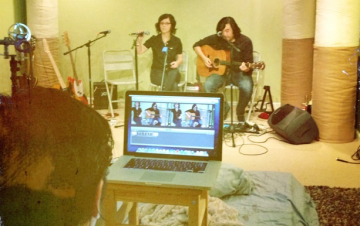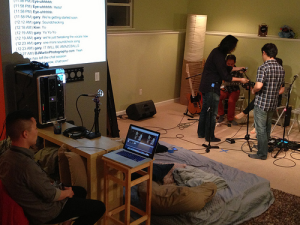Hacking the Performance Business: Part 8 – Telepresence

In 20 years, fans will be staying home to watch the show, rather than deal with the inconvenience of attending a live show.
In 20 years, going out to see a performance will be like sitting down to listen to a vinyl record, side to side, uninterrupted. Vinyl is enjoying a resurgence in popularity because the act of listening to, attending to, and focusing closely on the music is in stark contrast to the modern way of listening: In the background, supplementing another activity.
Live music, one day, will be the same way. It’s inevitable because of the rapid funding and advancement in technologies to keep us in our living rooms, entertained, and being fed marketing messages from governments and corporations (you are watching Big Brother).
Media is on an inexorable trend toward immersion. One can follow the nascent virtual reality device of today into a future of total sensory immersion in a virtual universe. It’s not science fiction, it’s starting to take hold right now, and probably a mere generation away.
One way we can see this taking hold is with “telepresence“, a fancy word for technologies that make you feel like you’re “there” when you’re not. Virtual Tupac is a great example of telepresence — except for the fact that Tupac is dead. But there is a future in which you get to embody Tupac in virtual reality and relive his song lyrics in fictionalized simulations of his life.
Not all of us have a million-dollar budget for special effects, and luckily there’s a much more practical and accessible version of telepresence that is quickly becoming the norm for communication: webcam.
Webcast as Performance
Webcam refers to any video device connected to the web with the intent of being “telepresent” with one or more people. The act of “webcasting” is performing on a webcam for an audience.
There is a growing number of services specifically for musicians and entertainers that allow fans to connect directly with artists, and give artists options on monetizing that experience.
Before we get into the specific technologies, a word on internet video. There tend to be two camps, those who feel comfortable in front of a camera, and those who don’t. I guess there’s a third camp that’s still trying to figure out how to feel comfortable in front of a camera.
As a modern musician, you should not be in the camp that feels uncomfortable being filmed. If you are and you can’t change, I guess you just have to find ways to cope with that, or you can be mysterious and wear a mask. Musicians are often as filmed and photographed as your average model.
Performing on camera is not exactly like performing on stage. There are plenty of similarities, but in many ways the webcast performance best practices amplify the concerns of a standard live show:
• Sound – You’re basically performing in your home recording studio, or at a live performance that already has sound running. You’re going to need to apply recording best practices and decent equipment to provide a quality experience for those watching and listening. The same rules as live performance apply, but now in addition you have to mix a stereo channel that’s going to be delivered to headphones and speakers.
• Lighting – If lighting is important on stage, it’s ten times more important on video. Anyone with any experience in photography or cinematography will tell you that lighting is the foundation of a good shot. Pay very close attention to your lighting and Google up on it before webcasting. You may need to buy some cheap lights if all you have are the lights in the room.
• Styling – The camera amplifies your image. On stage it’s easier to hide in the shadows, but a well-lit video recording studio feels more like an operating room. You want to look your best, especially since you’re under a microscope. For most people, this has less to do with vanity than with feeling comfortable and confident with the idea that people can scrutinize your every pore and follicle in HD. Even if it’s not in your wheelhouse, learn some basic styling tips for filming, or get some help. What you don’t see until you’ve been on set is that every time the camera is off, hair is being fixed, sweat is being dried, collars are being adjusted. During a live webcast, you can’t stop to style on the fly, so be confident that you look your best before the recording light comes on.
• Interactivity – Some of the services we’ll look at have tons of options for fans to chat with artists, tip them, send them pictures, etcetera. In fact you don’t really even have to do a musical performance to monetize a webcast. But one thing is true: because today’s webcast technology is more like a YouTube video than the 20-year vision of virtual reality immersion, you have to go the extra mile to draw your virtual audience into the performance. If it’s a concert, let them know you know they’re there. If it’s a home performance, take time to stop and chat with the fans just like you would at a show.
Musician Telepresence Technologies

Tunezy – Tunezy is monetizing the fan hangout. It’s a truly unique service that allows musicians to offer fans the ability to buy all types of hangout packages, from backstage VIP access to pre-show dinners to Skype chats and more. The possibilities are endless. Fans can also submit requests, and other fans can vote them up. Though the service is marketed to “YouTube Stars”, it’s gaining traction with musicians as a great solution to generate an additional revenue stream from top fans. The service is free to join, and Tunezy takes 15% of all revenue from these “experiences” that bands can sell to fans.
Stageit – Stageit is a fully realized online concert venue. With this platform, any independent musician can effortlessly monetize a live performance. The user experience is well-polished, and gives fans the opportunity chat with and tip the artist during the performance (along with whatever “cover” charge the musician sets for the show). Stageit makes the dream of performing a worldwide concert from your laptop a reality, while remaining truly accessible to the independent, unsigned artist.
Soundhalo – Soundhalo is the premiere live show digital delivery platform. Used by many high-profile artists, the platform is undeniably professional and polished. Live video syncs to multiple devices, and quality is consistently top-notch. Not only does Soundhalo deliver the live experience, it archives show video as well, so users can always return to favorites or catch shows they missed. Soundhalo is not an open platform, and is being built as more of a retail outlet for live music, but foward-thinking established acts capable of multi-camera, pro-audio show recording should contact the company immediately.
Your other options are to do more of a traditional pay-per-view model with Ustream or Livestream, both decent options when it comes to monetizing a performance on the cheap.
You could feasibly cobble together your own system with Google Hangouts and an event ticketing system, and provide paying customers with links.
Whatever path you take to webcasting glory, the idea is simple: start looking to the web for performance opportunities.
Conclusion
In this series, we’ve taken a look at how to create value around performance. It’s been quite in-depth, and yet we’ve only scratched the surface. That’s because performance is so individual to the musician, the venue, and the audience. There are so many variables to consider.
With composition, everyone is using the same blueprint to recreate your song. With recording, it’s the same copy of a performance over and over again.
Every performance is unique. You can try to record it but you will never capture the experience of being there as it unfolds live (whether in person or virtually). Increasingly, musicians are interacting directly with their fans to monetize the relationship, rather than relying on copyright exploitation and “moving units”.
We have two more chunks of knowledge to drop on you: our series on Composing, and our series on Recording. Following these, we’ll be announcing the release date for the eBook upon which these series are based. Sign up for our email list above to get your free copy!




















